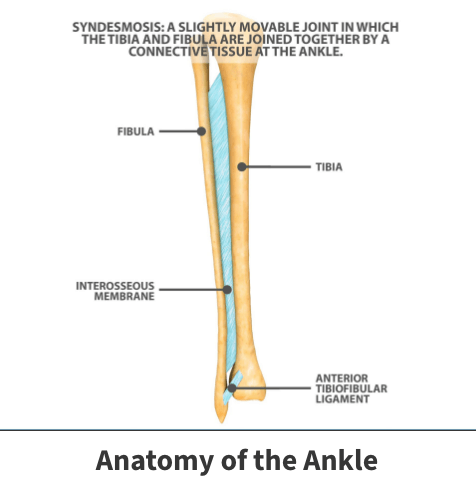High ankle sprain
Syndesmosis ligament injury
Few body parts bear as much importance as the ankles. These major joints hold the bones of your feet together, enable you to carry out vital actions like standing and walking and support your body’s weight.
These pressures often leave your feet vulnerable to gradual deterioration and acute (severe) damage. One rather serious injury is a high ankle sprain, also known as a syndesmosis ligament injury.
Anatomy

The ankle joint is comprised of many ligaments. In your ankle’s upper regions, these soft tissues connect the shin bone (the tibia) to the calf bone (the fibula).
The high ankle joint is called the syndesmosis. A syndesmosis is a slightly movable joint in which the tibia and fibula are joined together by a connective tissue at the ankle. It is crucial for providing ankle stability and enables you to perform just about every notable physical action.
About
A high ankle sprain, or a syndesmosis ligament injury, occurs when one or more of these tissues are stretched beyond their normal limits or even torn. Such events are typically acute, meaning they result from some type of immediate and blunt trauma. Usually, these are seen in athletic competitions but can also occur in falls or automobile accidents.
Causes
In a significant percentage of these injuries, ligaments become damaged due to an intense or violent twisting or rotating the foot and ankle.
Risk factors
If you compete in a contact sport or any type of competition necessitating a significant degree of running or jumping, your chance of sustaining a syndesmosis ligament injury increases. Specific sports include:
- Football
- Basketball
- Soccer
- Distance running
- Lacrosse
Additionally, a job requiring running or jumping might also heighten your risk. An example is a ballerina.

Symptoms
Symptoms can vary depending on how severe your injury is. The most apparent symptom is pain. Discomfort will grow more severe when performing activities requiring you to place full body weight on your high ankle ligaments – most notably climbing stairs.
Occasionally, more significant high ankle sprains are accompanied by bone fractures. You will likely be less able to place any weight on the affected foot or ankle, much less turn, walk, or possibly even stand up for short spurts.
Lower ankle sprains have major inflammation and swelling. But many orthopedists stress that high ankle sprains do not always have the same redness or swelling.
This lack of swelling might have you think your injury is not that severe. If any of the previously mentioned symptoms occur, you should temporarily stop all physical activities and receive a prompt medical evaluation.
Complications
If left untreated, high ankle sprains can worsen. This can leave your ankle vulnerable to fracture. Severer injuries need more aggressive treatment. Without treatment, they could eventually result in permanent disability and chronic pain.
Diagnosis
Diagnosis is often reached following several stages of examination.
During the first phase, your doctor will likely ask you questions relating to your injury, including:
- What activities were you engaging in when the pain and associated symptoms began?
- How well can you stand or walk?
- Do any specific movements worsen your discomfort?
- What symptoms are you experiencing?
After obtaining this information, your doctor will then perform a thorough visible examination. During this phase, they may also complete the squeeze and external rotation tests.
- The squeeze test – This involves your doctor squeezing the part of your leg immediately beneath your knee. If the discomfort associated with this event spreads to your ankle, you more than likely have a high ankle sprain.
- The external rotation test – Your orthopedic specialist performs this test by bending your knee and gently rotating your ankle in various directions. Should you experience more intense ankle pain, there is a good chance the problem is a high ankle sprain.
If your doctor cannot confirm the diagnosis, they may order diagnostic imaging tests, such as X-rays, magnetic resonance imaging (M.R.I.), and computerized tomography (C.T. scans).
Treatment
As is the case with most physical injuries, the treatment method your doctor chooses will hinge on how severe the sprain is and if other potential complications like bone fractures go with it. Specific therapy might also be influenced by factors including your:
- Age
- Overall health
- Current physical condition
- Weight
Above all, your fitness goals must also be considered. If you are a competitive athlete looking for a quicker return to your sport, you may wish to receive more aggressive treatment than someone holding less ambitious athletic aims.
Nonsurgical treatments
A significant percentage of minor to moderate high ankle sprains respond to a treatment technique known as the R.I.C.E. protocol. R.I.C.E. is an abbreviation for resting the injured ankle, applying ice, compressing the damaged ligaments, and keeping the injured body part elevated above your heart.
Rest takes the pressure off the ligaments and promotes healing. Ice soothes pain. Compression keeps damaged ligaments in place and prevents movement and the potential for further injury. Elevating the ankle above your heart increases blood flow.
Once the ligaments heal, your physician may recommend a course of physical therapy. When undergoing such treatment, you will perform a series of exercises geared towards restrengthening your ankles and helping said structures regain motion ranges.
Surgical options
Severe sprains involving ligament damage or complete tears are often treated surgically. The most commonly performed operation involves connecting your shin and calf bones using screws. This reduces the stress placed on the injured ligaments, allowing them to heal faster. Surgery is usually followed by a period of physical therapy.
Recovery
You will typically need anywhere from two to four months before returning to full athletic activities. The time frame will also depend upon the type of treatment you received. Naturally, if you undergo surgery, recovery will take longer to complete.
Prevention
Prevention often proves difficult because such injuries usually occur due to an unexpected movement or traumatic event. You might lessen your risk by stretching before engaging in a fitness schedule or athletic competition, participating in exercises designed to strengthen the bones, muscles, and soft tissues in and around the ankles, and taping or bracing your ankles in advance of physical activity.
Videos
Related specialties
- Achilles Calcific Tendinitis
- Achilles Tendon Rupture
- Achilles Tendonitis
- Ankle Fracture Surgery
- Ankle Fractures (Broken Ankle)
- Ankle Fusion Surgery
- Arthroscopic Articular Cartilage Repair
- Arthroscopy of the Ankle
- Bunions
- Charcot Joint
- Chronic Lateral Ankle Pain
- Common Foot Fractures in Athletes
- Foot Stress Fractures
- Hallux Rigidus Surgery - Cheilectomy
- Hammer Toe
- Intraarticular Calcaneal Fracture
- Lisfranc Injuries
- Mallet, Hammer & Claw Toes
- Metatarsalgia
- Neuromas (Foot)
- Plantar Fasciitis
- Posterior Tibial Tendonitis & Tears
- Sprained Ankle
- Total Ankle Replacement
- Turf Toe
